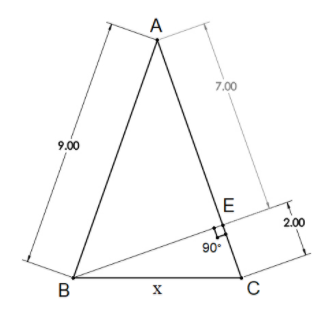
In the following figure of an isosceles triangle, find the value of $'x'$?
(All dimensions are in centimeter)


Answer
577.8k+ views
Hint: Notice that there are two right-angled triangles in the triangle $\Delta ABC$. They have a common side. Use Pythagoras’ theorem to find the measure of that side. Then use that value while applying Pythagoras’ theorem in another triangle to obtain the value of $'x'$.
Complete step-by-step answer:
Let’s analyse the question through the diagram first. Here we have an isosceles triangle $\Delta ABC$, which has an altitude $BE$ on the side $AC$. The altitude divides the $\Delta ABC$ into two right-angled triangles $\Delta BEC$ and $\Delta BEA$. Using all this information we need to find the value of $'x'$
If we notice $\Delta BEC$ in the figure, we can see that $x$ is the hypotenuse of this triangle.
Now we can use Pythagoras’ theorem that states that, “the sum of the squares of the sides of a right triangle is equal to the square on the hypotenuse”
Using Pythagoras’ theorem in $\Delta BEA$, we get:
$ \Rightarrow A{B^2} = B{E^2} + A{E^2}$
Now we can easily substitute the given values in the above equation
$ \Rightarrow {9^2} = B{E^2} + {7^2}$
$ \Rightarrow B{E^2} = 81 - 49 = 32$
$ \Rightarrow BE = \sqrt {32} = 4\sqrt 2 cm$
Similarly, again using Pythagoras’ theorem in $\Delta BEC$, we can see that:
$ \Rightarrow B{C^2} = B{E^2} + E{C^2}$
Let’s substitute the already known values in the above equation
$ \Rightarrow B{C^2} = {\left( {4\sqrt 2 } \right)^2} + {2^2} = 32 + 4 = 36$
$ \Rightarrow BC = x = 6 cm$
Hence, we got the value of $'x'$ as $6 cm$.
Note: Try to first understand all the given information in the diagram given in the question. Be careful while taking square root or squaring both sides in equations. An alternative approach to the problem is to apply Pythagoras’ theorem in both the right-angled triangles and equate for the value of $BE$. This will give you an equation with one unknown, i.e. $'x'$.
Complete step-by-step answer:
Let’s analyse the question through the diagram first. Here we have an isosceles triangle $\Delta ABC$, which has an altitude $BE$ on the side $AC$. The altitude divides the $\Delta ABC$ into two right-angled triangles $\Delta BEC$ and $\Delta BEA$. Using all this information we need to find the value of $'x'$
If we notice $\Delta BEC$ in the figure, we can see that $x$ is the hypotenuse of this triangle.
Now we can use Pythagoras’ theorem that states that, “the sum of the squares of the sides of a right triangle is equal to the square on the hypotenuse”
Using Pythagoras’ theorem in $\Delta BEA$, we get:
$ \Rightarrow A{B^2} = B{E^2} + A{E^2}$
Now we can easily substitute the given values in the above equation
$ \Rightarrow {9^2} = B{E^2} + {7^2}$
$ \Rightarrow B{E^2} = 81 - 49 = 32$
$ \Rightarrow BE = \sqrt {32} = 4\sqrt 2 cm$
Similarly, again using Pythagoras’ theorem in $\Delta BEC$, we can see that:
$ \Rightarrow B{C^2} = B{E^2} + E{C^2}$
Let’s substitute the already known values in the above equation
$ \Rightarrow B{C^2} = {\left( {4\sqrt 2 } \right)^2} + {2^2} = 32 + 4 = 36$
$ \Rightarrow BC = x = 6 cm$
Hence, we got the value of $'x'$ as $6 cm$.
Note: Try to first understand all the given information in the diagram given in the question. Be careful while taking square root or squaring both sides in equations. An alternative approach to the problem is to apply Pythagoras’ theorem in both the right-angled triangles and equate for the value of $BE$. This will give you an equation with one unknown, i.e. $'x'$.
Recently Updated Pages
Two men on either side of the cliff 90m height observe class 10 maths CBSE

What happens to glucose which enters nephron along class 10 biology CBSE

Cutting of the Chinese melon means A The business and class 10 social science CBSE

Write a dialogue with at least ten utterances between class 10 english CBSE

Show an aquatic food chain using the following organisms class 10 biology CBSE

A circle is inscribed in an equilateral triangle and class 10 maths CBSE

Trending doubts
Why is there a time difference of about 5 hours between class 10 social science CBSE

Write a letter to the principal requesting him to grant class 10 english CBSE

What is the median of the first 10 natural numbers class 10 maths CBSE

The Equation xxx + 2 is Satisfied when x is Equal to Class 10 Maths

Which of the following does not have a fundamental class 10 physics CBSE

State and prove converse of BPT Basic Proportionality class 10 maths CBSE




